Time Series Analysis of Evaporation Duct Height over South China Sea: A Stochastic Modeling Approach
Abstract
:1. Introduction
2. Data and Methodology
2.1. Study Area
2.2. Monthly EDH Data
2.3. ARIMA Modeling Approach
2.4. Model Verification and Comparison Criteria
3. Results and Discussion
3.1. Annual and Monthly EDH Variability
3.2. ARIMA Modeling
4. Conclusions
Author Contributions
Funding
Institutional Review Board Statement
Informed Consent Statement
Data Availability Statement
Conflicts of Interest
Abbreviations
| ARIMA | Autoregressive integrated moving average |
| EDH | Evaporation duct height |
| SCS | South China Sea |
| NCEP | National Centers for Environmental Prediction |
| CFSR | Climate Forecast System Reanalysis |
| ACF | Autocorrelation function |
| PACF | Partial autocorrelation function |
| BIC | Bayesian information criterion |
| RMSE | Root of the mean square error |
| MAPE | Mean absolute percentage error |
| JUST | Jumps Upon Spectrum and Trend |
References
- Dinc, E.; Akan, O. Beyond-line-of-sight communications with ducting layer. IEEE Commun. Mag. 2014, 10, 37–43. [Google Scholar] [CrossRef]
- Wang, J.; Zhou, H.; Li, Y.; Sun, Q.; Wu, Y.; Jin, S.; Quek, T.Q.; Xu, C. Wireless channel models for maritime communications. IEEE Access 2018, 6, 68070–68088. [Google Scholar] [CrossRef]
- Woods, G.S. High-Capacity, Long-Range, Over ocean microwave link using the evaporation duct. IEEE J. Ocean. Eng. 2009, 3, 323–330. [Google Scholar] [CrossRef]
- Zhang, Q.; Yang, K.D.; Shi, Y.; Yan, X.D. Oceanic propagation measurement in the northern part of the South China Sea. In Proceedings of the IEEE OCEANS 2016-Shanghai, Shanghai, China, 10–13 April 2016. [Google Scholar]
- Zhang, Q.; Yang, K.D. Study on evaporation duct estimation from point-to-point propagation measurements. IET Sci. Meas. Technol. 2018, 4, 456–460. [Google Scholar] [CrossRef]
- Shi, Y.; Yang, K.D.; Yang, Y.X.; Ma, Y.L. A new evaporation duct climatology over the South China Sea. J. Meteorol. Res. 2015, 5, 764–778. [Google Scholar] [CrossRef]
- Zhang, Q.; Yang, K.D.; Shi, Y. Spatial and temporal variability of the evaporation duct in the Gulf of Aden. Tellus A 2016, 68, 29792. [Google Scholar] [CrossRef] [Green Version]
- Yang, K.D.; Zhang, Q.; Shi, Y.; He, Z.Y.; Lei, B.; Han, Y.N. On Analyzing Space-time Distribution of Evaporation Duct Height over the Global Ocean. Acta Oceanol. Sin. 2016, 7, 20–29. [Google Scholar] [CrossRef]
- Yang, K.D.; Zhang, Q.; Shi, Y. Interannual variability of the evaporation duct over the South China Sea and its relations with regional evaporation. J. Geophys. Res. Oceans 2017, 8, 6698–6713. [Google Scholar] [CrossRef]
- Ghaderpour, E.; Pagiatakis, S.D.; Hassan, Q.K. A Survey on Change Detection and Time Series Analysis with Applications. Appl. Sci. 2021, 11, 6141. [Google Scholar] [CrossRef]
- Box, G.E.P.; Jenkins, G.M.; Reinsel, G.C.; Ljung, G.M. Time Series Analysis: Forecasting and Control; John Wiley and Sons Inc.: Hoboken, NJ, USA, 2015; p. 712. [Google Scholar]
- Kozitsin, V.; Katser, I.; Lakontsev, D. Online Forecasting and Anomaly Detection Based on the ARIMA Model. Appl. Sci. 2021, 11, 3194. [Google Scholar] [CrossRef]
- Sim, S.K.; Maass, P.; Lind, P.G. Wind speed modeling by nested ARIMA processes. Energies 2019, 12, 69. [Google Scholar] [CrossRef] [Green Version]
- Eymen, A.; Köylü, Ü. Seasonal trend analysis and ARIMA modeling of relative humidity and wind speed time series around Yamula Dam. Meteorol. Atmos. Phys. 2019, 3, 601–612. [Google Scholar] [CrossRef]
- Odai, A.; Babbar, R.; Karmaker, T. Trend analysis and ARIMA modeling for forecasting precipitation pattern in Wadi Shueib catchment area in Jordan. Arab. J. Geosci. 2019, 2, 27. [Google Scholar]
- Wang, H.; Huang, J.J.; Zhou, H.; Zhao, L.X.; Yuan, Y.B. An Integrated Variational Mode Decomposition and ARIMA Model to Forecast Air Temperature. Sustainability 2019, 11, 4018. [Google Scholar] [CrossRef] [Green Version]
- Salles, R.; Mattos, P.; Iorgulescu, A.D.; Bezerra, E.; Lima, L.; Ogasawara, E. Evaluating temporal aggregation for predicting the sea surface temperature of the Atlantic Ocean. Ecol. Inform. 2016, 36, 94–105. [Google Scholar] [CrossRef]
- Natsagdorj, E.; Renchin, T.; Maeyer, P.D.; Darkhijav, B. Spatial Distribution of Soil Moisture in Mongolia Using SMAP and MODIS Satellite Data: A Time Series Model (2010–2025). Remote Sens. 2021, 13, 347. [Google Scholar] [CrossRef]
- Yang, S.B.; Liu, S.H.; Li, X.F.; Zhong, Y.; He, X.; Wu, C. The short-term forecasting of evaporation duct height (EDH) based on ARIMA model. Multimed. Tools Appl. 2016, 23, 24903–24916. [Google Scholar] [CrossRef]
- McKeon, B.D. Climate Analysis of Evaporation Ducts in the South China Sea. Master’s Thesis, Naval Postgraduate School, Monterey, CA, USA, 2013. [Google Scholar]
- Zaidi, K.S.; Jeoti, V.; Drieberg, M.; Awang, A.; Iqbal, A. Fading characteristics in evaporation duct: Fade margin for a wireless link in the South China Sea. IEEE Access 2018, 6, 11038–11045. [Google Scholar] [CrossRef]
- Shi, Y.; Yang, K.D.; Yang, Y.X.; Ma, Y.L. Experimental verification of effect of horizontal inhomogeneity of evaporation duct on electromagnetic wave propagation. Chin. Phys. B 2015, 4, 044102. [Google Scholar] [CrossRef]
- Shi, Y.; Yang, K.D.; Yang, Y.X.; Ma, Y.L. Influence of obstacle on electromagnetic wave propagation in evaporation duct with experiment verification. Chin. Phys. B 2015, 4, 054101. [Google Scholar] [CrossRef]
- Shi, Y.; Zhang, Q.; Wang, S.W.; Yang, K.D.; Yang, Y.X.; Yan, X.D.; Ma, Y.L. A comprehensive study on maximum wavelength of electromagnetic propagation in different evaporation ducts. IEEE Access 2019, 7, 82308–82319. [Google Scholar] [CrossRef]
- Zhang, Q.; Yang, K.D.; Yang, Q.L. Statistical analysis of the quantified relationship between evaporation duct and oceanic evaporation for unstable conditions. J. Atmos. Ocean. Technol. 2017, 11, 2489–2497. [Google Scholar] [CrossRef]
- Babin, S.M.; Dockery, G.D. LKB-based evaporation duct model comparison with buoy data. J. Appl. Meteorol. 2002, 4, 434–446. [Google Scholar] [CrossRef]
- Frederickson, P.A.; Davidson, K.L.; Goroch, A.K. Operational Bulk Evaporation Duct Model for MORIAH Version 1.2.; Tech. Rep.; Naval Postgraduate School: Monterey, CA, USA, 2000. [Google Scholar]
- Saha, S.; Moorthi, S.; Pan, H.L.; Wu, X.; Wang, J.; Nadiga, S.; Tripp, P.; Kistler, R.; Woollen, J.; Behringer, D.; et al. The NCEP climate forecast system reanalysis. Bull. Am. Meteorol. Soc. 2010, 8, 1015–1058. [Google Scholar] [CrossRef]
- Frederickson, P.A.; Murphree, J.T.; Twigg, K.L.; Barrios, A. A modern global evaporation duct climatology. In Proceedings of the IEEE International Conference on Radar, Adelaide, SA, Australia, 2–5 September 2008; pp. 292–296. [Google Scholar]
- Ghaderpour, E.; Vujadinovic, T. Change Detection within Remotely Sensed Satellite Image Time Series via Spectral Analysis. Remote Sens. 2020, 12, 4001. [Google Scholar] [CrossRef]
- Ghaderpour, E.; Vujadinovic, T. The Potential of the Least-Squares Spectral and Cross-Wavelet Analyses for Near-Real-Time Disturbance Detection within Unequally Spaced Satellite Image Time Series. Remote Sens. 2020, 12, 2446. [Google Scholar] [CrossRef]
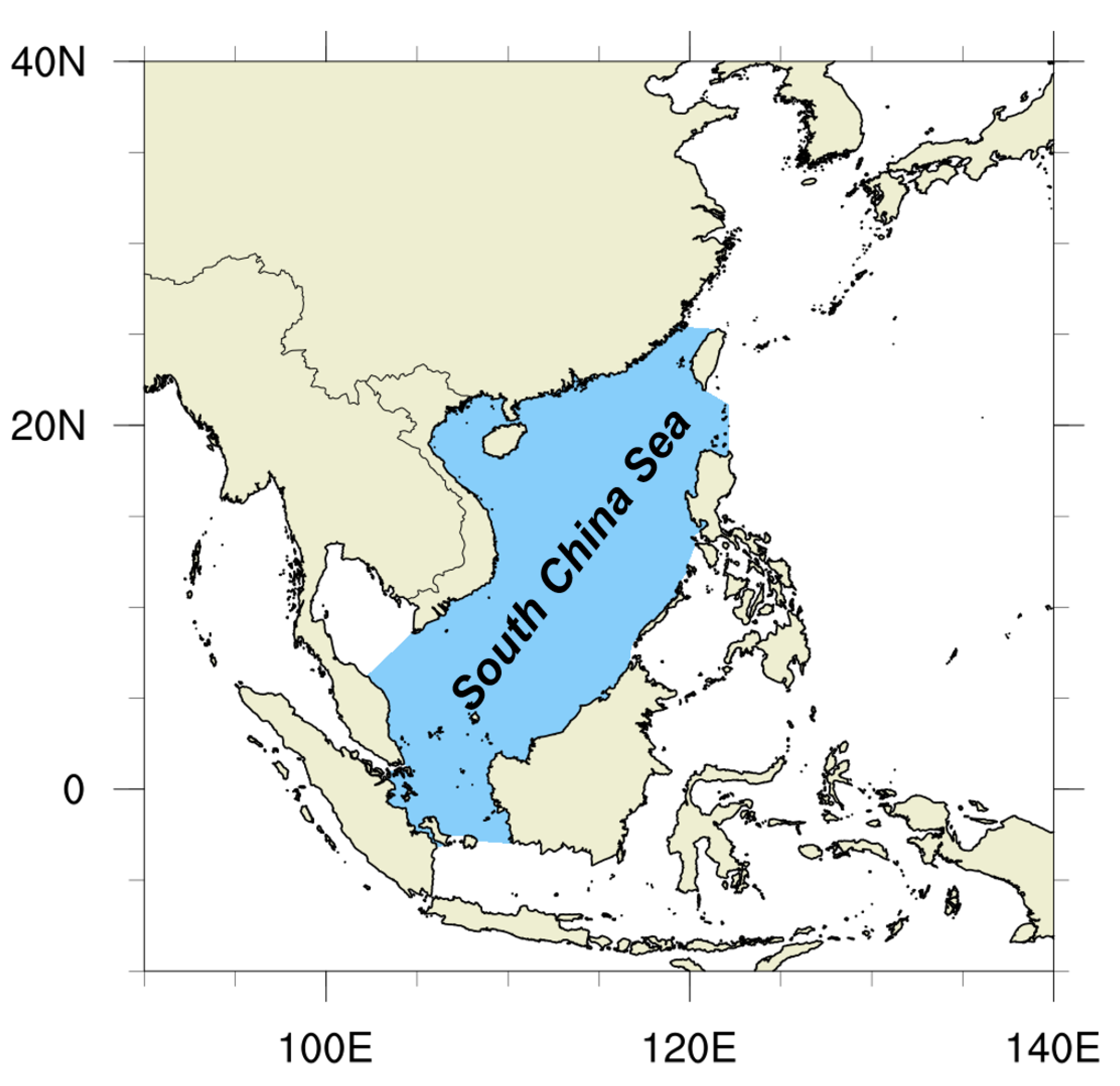
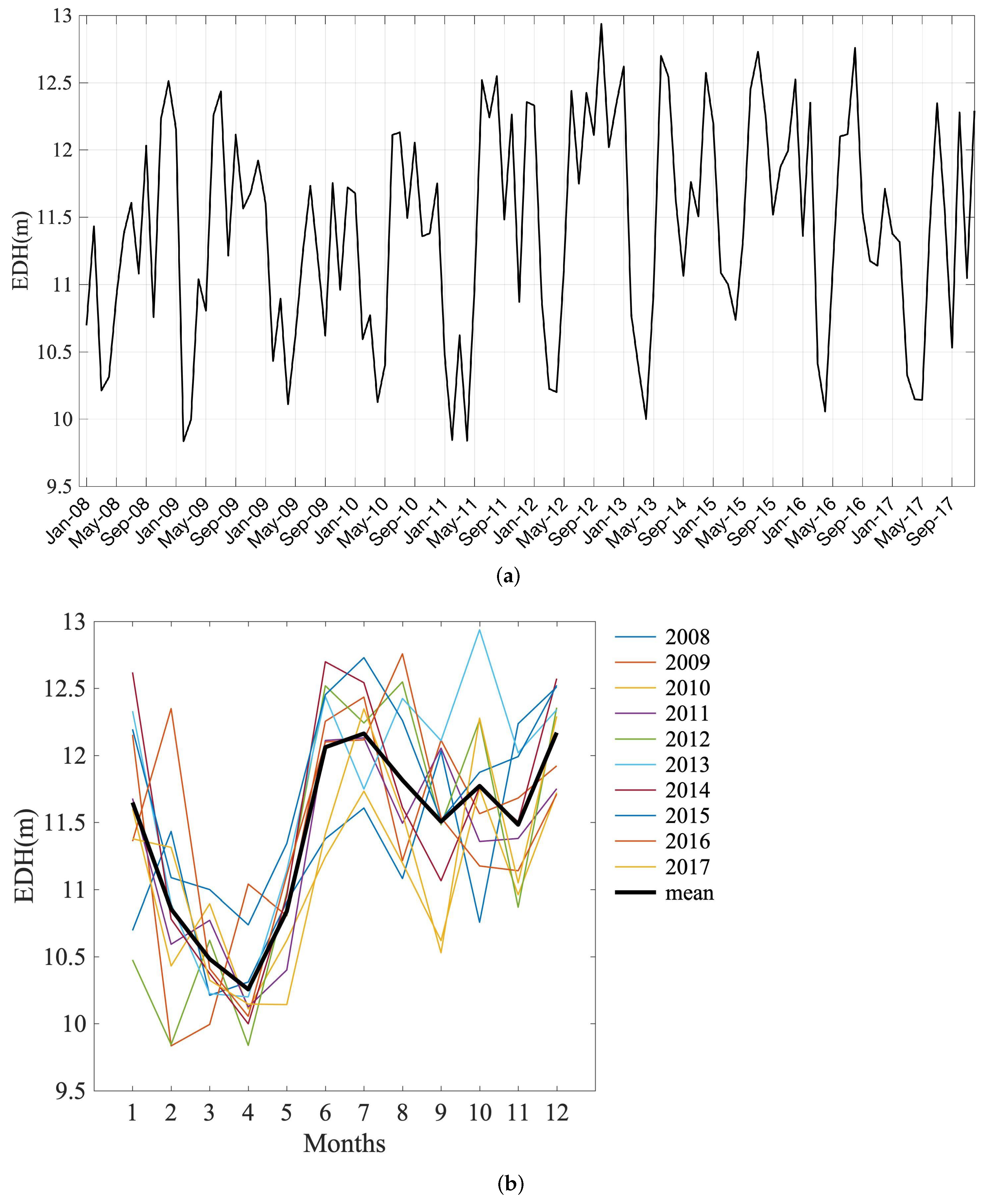
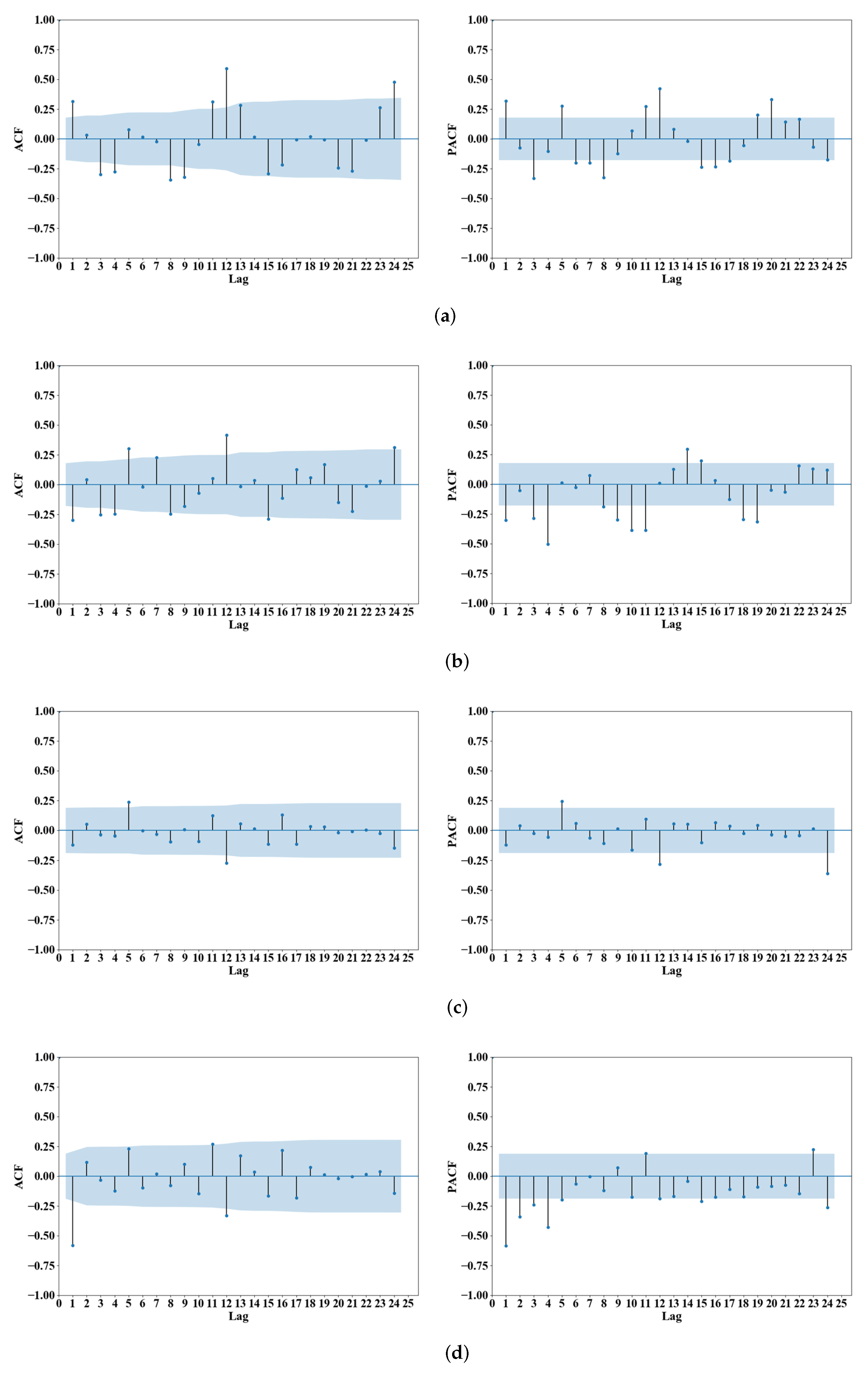
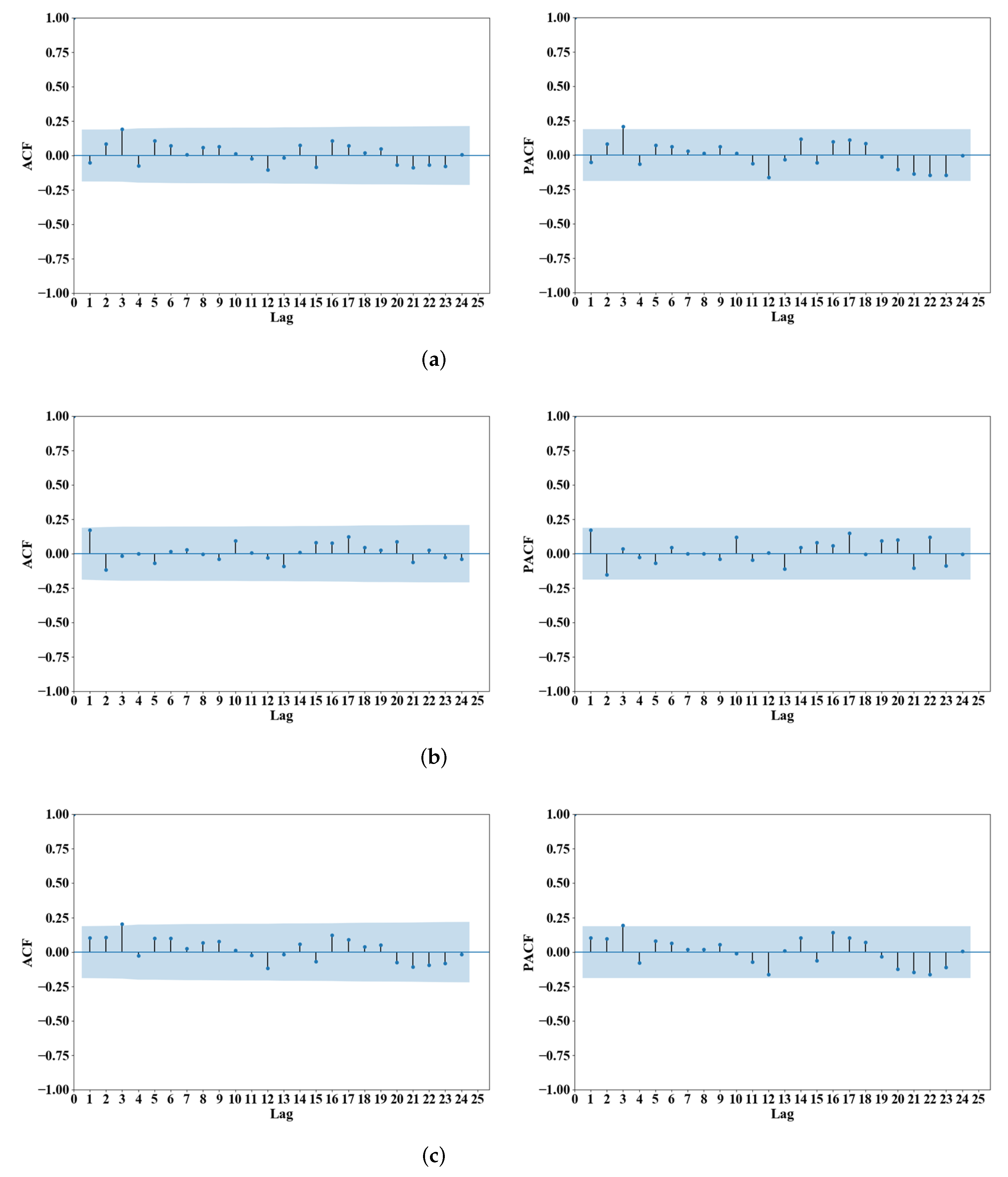
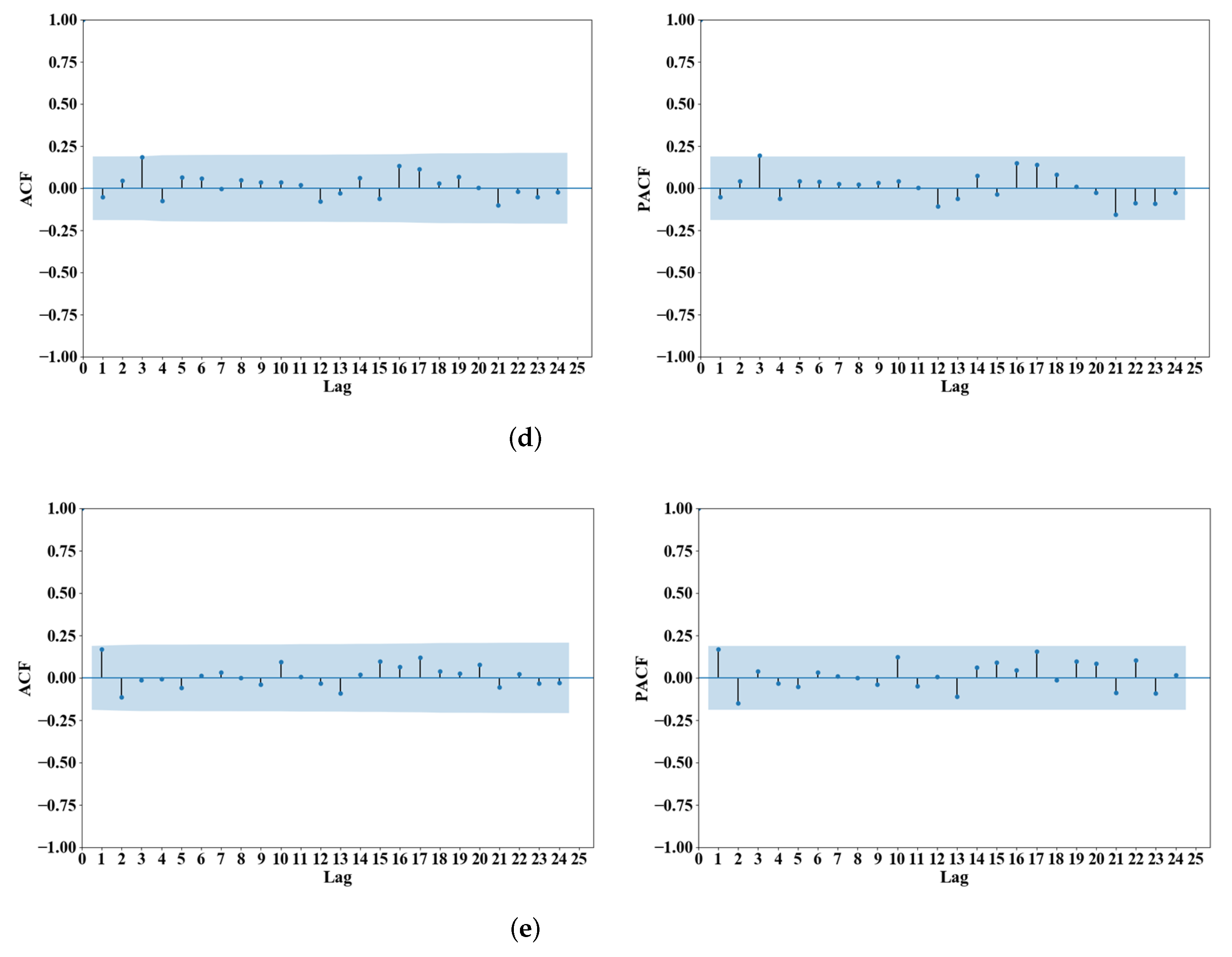
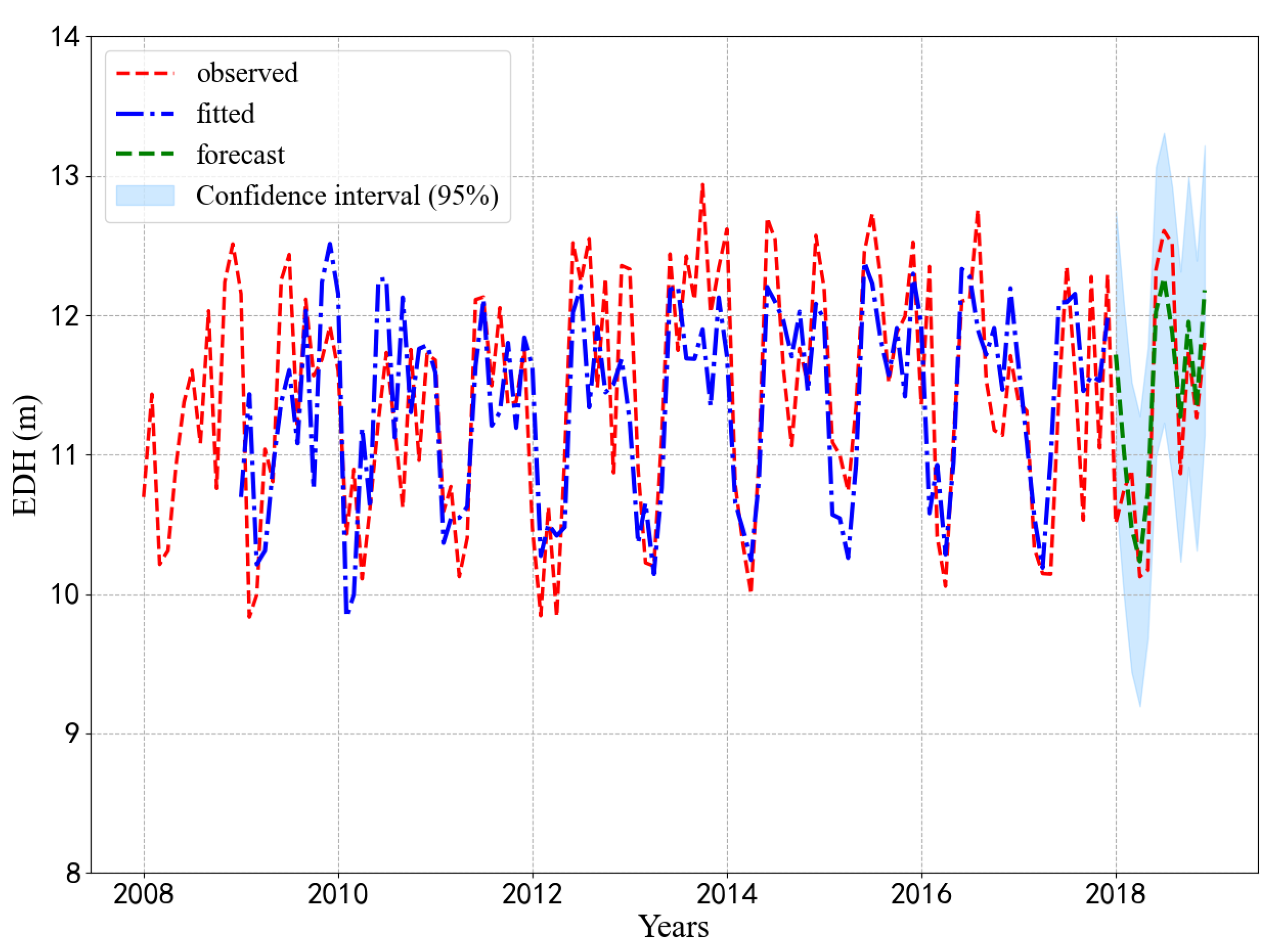
| Model Num. | Model | BIC | RMSE | MAPE |
|---|---|---|---|---|
| 1 | (0,0,1) × (0,1,2) | 150.426 | 0.604 | 0.042 |
| 2 | (1,0,1) × (0,1,2) | 150.649 | 1.066 | 0.051 |
| 3 | (0,0,0) × (0,1,2) | 151.578 | 0.612 | 0.043 |
| 4 | (1,0,0) × (0,1,2) | 152.178 | 0.605 | 0.043 |
| 5 | (1,0,2) × (0,1,2) | 153.337 | 1.044 | 0.051 |
| Months | Actual | Predicted | Residuals |
|---|---|---|---|
| January 2018 | 10.508 | 11.718 | −1.210 |
| February 2018 | 10.747 | 11.017 | −0.270 |
| March 2018 | 10.887 | 10.480 | 0.407 |
| April 2018 | 10.124 | 10.235 | −0.111 |
| May 2018 | 10.171 | 10.728 | −0.557 |
| June 2018 | 12.326 | 12.024 | 0.302 |
| July 2018 | 12.607 | 12.268 | 0.339 |
| August 2018 | 12.512 | 11.876 | 0.636 |
| September 2018 | 10.863 | 11.273 | −0.410 |
| October 2018 | 11.748 | 11.954 | −0.206 |
| November 2018 | 11.264 | 11.351 | −0.087 |
| December 2018 | 11.803 | 12.180 | −0.377 |
Publisher’s Note: MDPI stays neutral with regard to jurisdictional claims in published maps and institutional affiliations. |
© 2021 by the authors. Licensee MDPI, Basel, Switzerland. This article is an open access article distributed under the terms and conditions of the Creative Commons Attribution (CC BY) license (https://creativecommons.org/licenses/by/4.0/).
Share and Cite
Hong, F.; Zhang, Q. Time Series Analysis of Evaporation Duct Height over South China Sea: A Stochastic Modeling Approach. Atmosphere 2021, 12, 1663. https://doi.org/10.3390/atmos12121663
Hong F, Zhang Q. Time Series Analysis of Evaporation Duct Height over South China Sea: A Stochastic Modeling Approach. Atmosphere. 2021; 12(12):1663. https://doi.org/10.3390/atmos12121663
Chicago/Turabian StyleHong, Fei, and Qi Zhang. 2021. "Time Series Analysis of Evaporation Duct Height over South China Sea: A Stochastic Modeling Approach" Atmosphere 12, no. 12: 1663. https://doi.org/10.3390/atmos12121663
APA StyleHong, F., & Zhang, Q. (2021). Time Series Analysis of Evaporation Duct Height over South China Sea: A Stochastic Modeling Approach. Atmosphere, 12(12), 1663. https://doi.org/10.3390/atmos12121663






